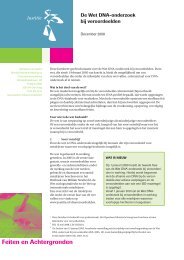INTERPOL HANDBOOK ON DNA DATA EXCHANGE AND PRACTICE
INTERPOL HANDBOOK ON DNA DATA EXCHANGE AND PRACTICE
INTERPOL HANDBOOK ON DNA DATA EXCHANGE AND PRACTICE
You also want an ePaper? Increase the reach of your titles
YUMPU automatically turns print PDFs into web optimized ePapers that Google loves.
• Consider physical evidence that may be left on aeroplanes or at destinationairports.• Identify all surveillance (CCTV) cameras and secure all tapes or images.Scenario:The cleaning supervisor – who is he? Obtain all relevant information about hisbackground.• Should he be on duty at this time?• Everything appeared ‘normal’ – What is normal for the cleaning supervisor?• Examine and collect any fingerprints or <strong>DNA</strong>, footprints/shoe marks, samples fromthe scene.• Consider– reference/elimination samples from the supervisor.• Is there any reason to collect his clothes?• Consider legal issues, is the supervisor a witness or suspect at this time?The Body:• Cause and time of death?• Any distinctive features that may aid identification?• Any further identifiable evidence about the crime or the perpetrator?The Victim:• Who is she?• Is she airport staff?• Is there an ID-card present?• Is her clothing a uniform?• Does the victim have any keys for the room?• Is she a passenger?• Is there any unattended luggage left nearby?• Any flight or identity documents?• Is anyone missing from a recent flight?• Does she have a mobile telephone?• Is the victim seen on any CCTV and was she with anyone?When the body is formally identified we must confirm all the relevant informationabout the victim, and ascertain whether there is any property missing.Can we identify any apparent connection to the cleaning supervisor?Information relating to the scene, the body and all persons known to be associatedwith the circumstances or area should be considered in the context of forensic (<strong>DNA</strong>)examination as all could require processing for evidentiary or elimination purposes.(For more questions for consideration when using <strong>DNA</strong> in investigations see Appendix 4)INVESTIGATIVE APPROACH TO THE FICTITIOUSSCENARIOPAGE 17







